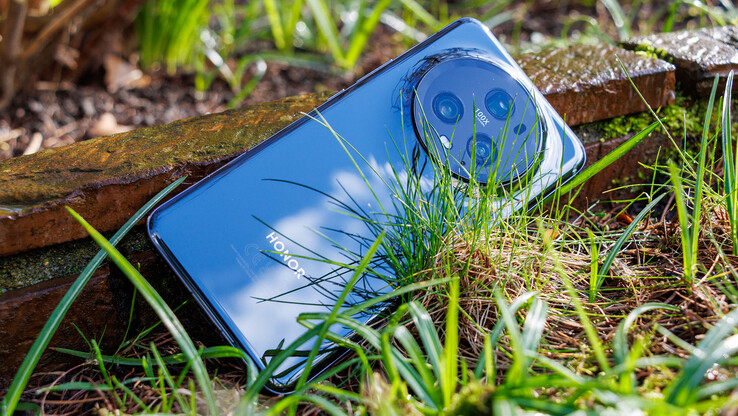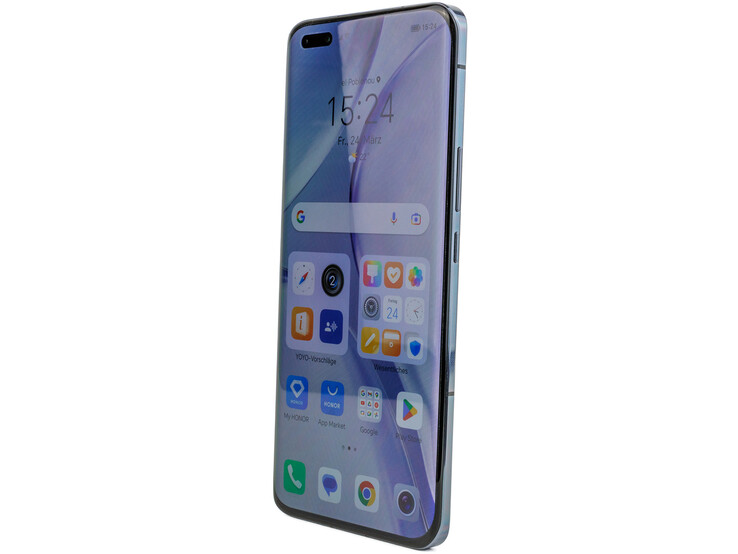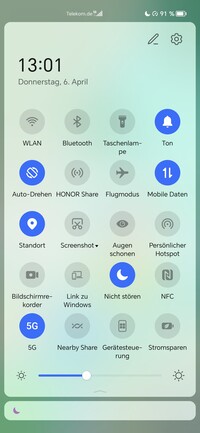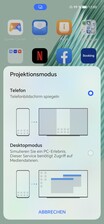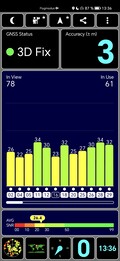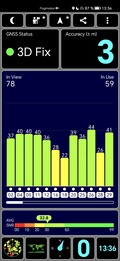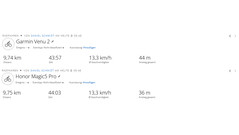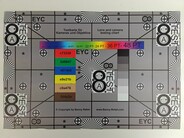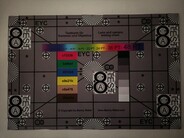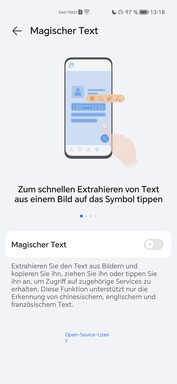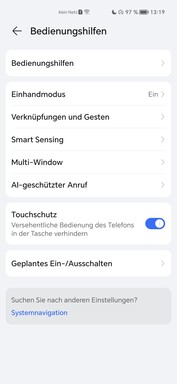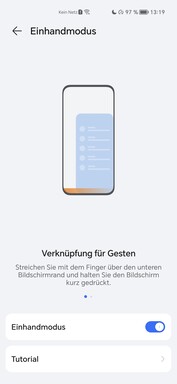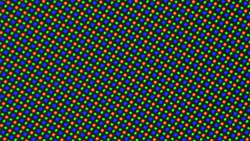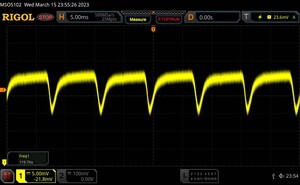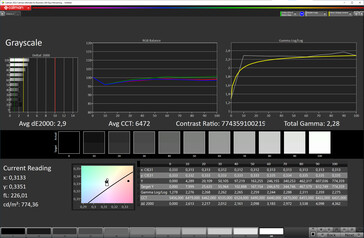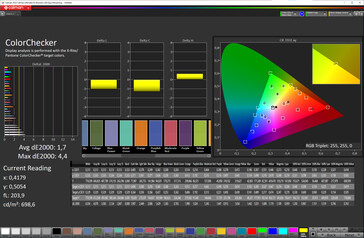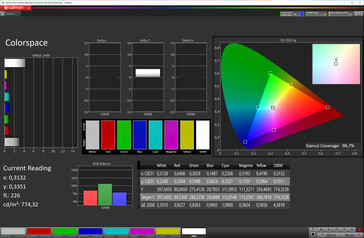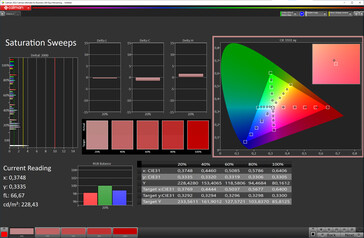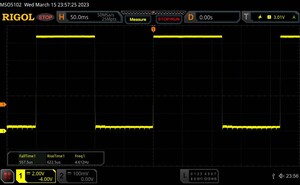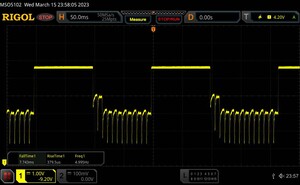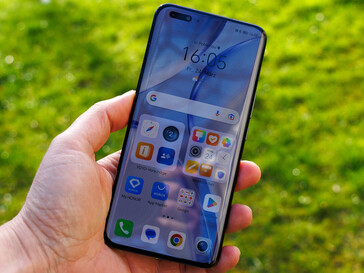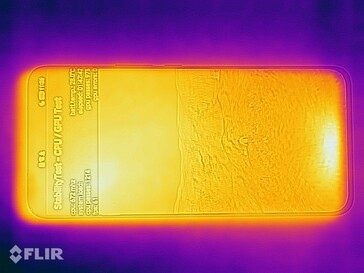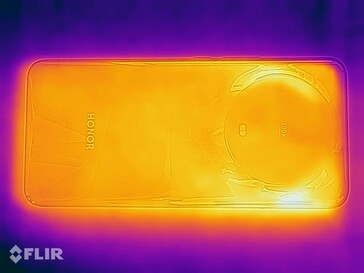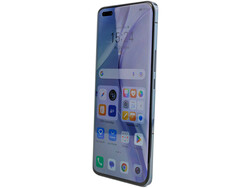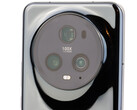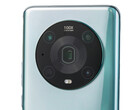Honor Magic5 Pro review - The smartphone with the full high-end experience
As expected, the Magic4 Pro is followed by the Honor Magic5 Pro. Honor has upgraded its already powerful flagship smartphone, bringing it to the current state of technology in many areas, but there is also a couple of downgrades as well.
In Germany, only the large storage version with 12 GB of working memory and 512 GB of internal storage will be available. In other countries, you can additionally purchase a model with 8 GB and 256 GB.
Honor also improves the availability of updates, extending the period of guaranteed updates. The price increases by 100 Euros (~$109) compared to the predecessor, now reaching 1,200 Euros (~$1310). Find out in our test, whether it is worth the price.
Possible Competitors in Comparison
Rating | Date | Model | Weight | Drive | Size | Resolution | Price |
|---|---|---|---|---|---|---|---|
| 90.1 % v7 (old) | 07 / 2023 | Honor Magic5 Pro SD 8 Gen 2, Adreno 740 | 219 g | 512 GB UFS 4.0 Flash | 6.81" | 2848x1312 | |
| 91.1 % v7 (old) | 03 / 2023 | Samsung Galaxy S23 Ultra SD 8 Gen 2 for Galaxy, Adreno 740 | 233 g | 256 GB UFS 4.0 Flash | 6.80" | 3080x1440 | |
| 90.3 % v7 (old) | 03 / 2023 | Apple iPhone 14 Pro Max A16, A16 GPU 5-Core | 240 g | 128 GB NVMe | 6.70" | 2796x1290 | |
| 89.1 % v7 (old) | 11 / 2022 | Google Pixel 7 Pro Tensor G2, Mali-G710 MP7 | 212 g | 128 GB UFS 3.1 Flash | 6.70" | 3120x1440 | |
| 89.2 % v7 (old) | 03 / 2023 | Xiaomi 13 Pro SD 8 Gen 2, Adreno 740 | 229 g | 256 GB UFS 4.0 Flash | 6.73" | 3200x1440 | |
| 89.3 % v7 (old) | 10 / 2022 | Motorola Edge 30 Ultra SD 8+ Gen 1, Adreno 730 | 198.5 g | 256 GB UFS 3.1 Flash | 6.67" | 2400x1080 |
Case - Magic5 Pro with a Catalonian bulge
Here in Germany, the Honor Magic5 Pro is available in the colors Black and Meadow Green, with the rest of the color options Coral, Orange (artificial leather) and Blue remaining reserved for the Asian market. While the black model is polished to high gloss, the green model is matte with a slight shimmer.
The thickness of the Magic5 Pro is specified as 8.77 millimeters (~0.35 in), but we measure a clean 9 millimeters, and it is even 12.15 millimeters (~0.48 in) with the camera. The rounded corners all around make the Honor smartphone appear slimmer, and it fits comfortably in the hand. Despite its prominent camera module, it is not too top heavy. The slightly rising bulge toward the camera is called Gaudí Curve as a tribute to the famous Catalonian architect Antoni Gaudí.
The workmanship of the Magic5 Pro is excellent and appears to be of a high quality. In both front and back, glass is used, but the type isn't specified. In the state of delivery, the glass is covered by a protective foil. Another particularity are the rounded display edges on all four sides. The gaps are very tight and even. When trying to warp the smartphone, it appears very robust, but creaks easily.
The color of the SIM tray cover is identical to that of the aluminum frame, but it is slightly darker in the green model. The card tray is able to accept up to two Nano SIM cards. In addition, the Magic5 Pro is dust and waterproof according to the IP68 certification.
Equipment - Fast USB 3.2 but no UWB
Like its predecessor, the Magic5 Pro uses a fast USB 3.2 port as the physical connection. In our test of the data transfers, it achieves a transfer speed of 502 MB/s. With this, it presents itself as significantly faster than for example the Galaxy S23 Ultra (285 MB/s), which nominally uses the same standard. OTG is also supported, allowing you to connect peripheral devices and external storage media to the smartphone. Wired display output is also possible.
The is an infrared transmitter to control home multimedia devices, air conditioning units, or cameras. NFC is available for contactless payments, but you have to make do without UWB.
Software - Honor MagicOS 7.1 and five years of updates
The Honor Magic5 Pro is delivered with Google Android 13 and the in-house MagicOS 7.1 user interface. At the time of this test, the security patches are at the level of February 1, 2023, so they are still fairly current. Honor has extended the period of updates, promising three major software updates up to Android 16 and five years of security patches.
MagicOS offers some new features, including a note app that can be synchronized across devices and the option to copy text and phone numbers from pictures. If you connect the Honor smartphone via cable to a display or TV, you can simply mirror the display contents or use a desktop mode. The smartphone can then be used as a trackpad to control the mouse cursor.
In addition to a few apps from the manufacturer, Honor also installs several third-party apps, including Booking, Netflix, and TikTok, but these can all be uninstalled completely.
Communication and GNSS - Magic5 Pro comes without 6-GHz WLAN
In terms of the communication characteristics, the Honor Magic5 Pro presents itself very modern on the spec sheet, also handling 5G Sub6 with a wide frequency band support and Wi-Fi 7. However, the latter comes with some limitations in practice, since although the smartphone supports the "be" standard for WLAN, it is not able to use the 6-GHz network. This limits the options for a potentially fast wireless connection unnecessarily.
In combination with our Asus ROG Rapture GT-AXE11000 reference router, the transfer rates of the Magic5 Pro still turn out very good, since Honor uses the 160-MHz spectrum (VHT160). The connection stability also gives no reason for complaint.
| Networking | |
| Honor Magic5 Pro | |
| iperf3 receive AXE11000 | |
| iperf3 transmit AXE11000 | |
| Samsung Galaxy S23 Ultra | |
| iperf3 receive AXE11000 | |
| iperf3 transmit AXE11000 | |
| iperf3 transmit AXE11000 6GHz | |
| iperf3 receive AXE11000 6GHz | |
| Apple iPhone 14 Pro Max | |
| iperf3 receive AXE11000 | |
| iperf3 transmit AXE11000 | |
| Google Pixel 7 Pro | |
| iperf3 receive AXE11000 | |
| iperf3 transmit AXE11000 | |
| iperf3 transmit AXE11000 6GHz | |
| iperf3 receive AXE11000 6GHz | |
| Xiaomi 13 Pro | |
| iperf3 receive AXE11000 | |
| iperf3 transmit AXE11000 | |
| iperf3 transmit AXE11000 6GHz | |
| iperf3 receive AXE11000 6GHz | |
| Motorola Edge 30 Ultra | |
| iperf3 receive AXE11000 | |
| iperf3 transmit AXE11000 | |
| iperf3 transmit AXE11000 6GHz | |
| iperf3 receive AXE11000 6GHz | |
| Honor Magic4 Pro | |
| iperf3 receive AXE11000 | |
| iperf3 transmit AXE11000 | |
| Average of class Smartphone | |
| iperf3 receive AXE11000 | |
| iperf3 transmit AXE11000 | |
| iperf3 transmit AXE11000 6GHz | |
| iperf3 receive AXE11000 6GHz | |
Even indoors, the Honor Magic5 Pro creates a satellite connection very quickly and accurately. To locate itself, the smartphone supports the four largest satellite networks in all the possible frequency bands.
We compare the Magic5 Pro with a Garmin Venu 2, taking them on a short bike tour. The length of the recorded route is almost identical, and the accuracy of the recording is at a similar level, making the Honor smartphone very well suited for navigation tasks.
Phone Functions and Voice Quality
In terms of phone functions, the Honor Magic5 Pro supports VoLTE and WLAN calls, but SIP Konen management is not implemented in the system. The smartphone is also dual SIM capable and can either use two Nano SIMs or an eSIM instead. You can also combine eSIM and a Nano SIM, but dual eSIM is not possible.
Holding the phone to your ear, the voice quality is really good, and the Magic5 Pro also succeeds in suppressing surrounding noises very well. In speaker mode, the smartphone has only a minimal echo, but the volume could be louder.
A special function is the AI protected call, where the volume of the call is adjusted according to the noise level of the surroundings, thereby ensuring that the caller cannot be heard by others that are around, while still making sure that the user can be understood easily.
Cameras - Three 50-MP sensors and 100x zoom
In front are two lenses behind the slightly larger display notch. One of them is a 12-MP camera and the other, the 3D sensor for the face recognition. Although the camera doesn't have an autofocus, it still succeeds in taking very attractive selfies, even under weaker light conditions. The portrait mode offers many setting options for the object, such as a softening mode or an adjustment of the face contours and skin tone. In addition, you can also deactivate the Bokeh mode. Even though that blurs the background very nicely, it has some difficulties with hair sticking out. Videos can be recorded in Ultra HD at 30 FPS.
The main camera offers a resolution of up to 50 MP and possesses a relatively large sensor area, even if those of the Vivo X90 Pro and Xiaomi 13 Pro are even larger. With the pixel binning process, four adjacent pixels are combined into one large pixel, resulting in 12.2-MP photos. You can choose among the 4:3, 1:1, and full screen image formats. Pictures taken in daylight impress with a balanced color composition without any exaggerated sharpening. In pictures taken in the dark, objects are brightened significantly, easily causing the details to look washed out. In this regard, Honor will probably still provide some improvements via updates.
The ultrawide-angle lens also offers a 50-MP resolution, delivering attractive pictures. The depth sharpness is rich in detail and convincing even in the edge areas. In addition, this lens is also handling macro recording. However, here the algorithm tends to even out some areas too much. It can also take some time, before the phone realizes that it has to switch. But the settings also offer a manual switching mode.
The third 50-MP lens of the group is a 3.5x zoom lens with optical image stabilization (OIS). Although the quality of the lens drops quickly in low light conditions, it still strikes a good figure in daylight, even with longer focal distances. While a maximum zoom level of 100x sounds pretty good, it hardly succeeds in taking attractive pictures. The image stabilization succeeds fairly well, but the Galaxy S23 Ultra still stays noticeably more composed when holding it in the hand, particularly with long focal lengths.
In summary, the Magic5 Pro succeeds in taking good to very good pictures, and the smartphone offers a very complete overall package that is additionally rounded by a high camera speed. Not only does the camera start up quickly, but the autofocus is also very fast, and the shutter release delay turns out very short.
In terms of recording videos, the Honor Magic5 Pro also offers some good features, being able to record videos in Ultra HD resolution at up to 60 FPS, if you use the 16:9 format. If you also want to record in HDR10+ or need the 21:9 format, you have to switch to filming mode, but then you can only choose among 24 and 30 FPS. In addition, a 10-bit LOG mode is also available. You can switch to ultrawide-angle during a recording, but zooming only works digitally with zoom levels up to 10x.
Image comparison
Choose a scene and navigate within the first image. One click changes the position on touchscreens. One click on the zoomed-in image opens the original in a new window. The first image shows the scaled photograph of the test device.
HauptkameraHauptkameraUltraweitwinkel5-facher ZoomLow-LightWhen recording our test chart under controlled light conditions, the picture looks attractive at first glance, but the details are slightly blurry.
The color reproduction is not exaggerated but presents the colors relatively naturally. Only bright red has a DeltaE > 10. However, the white balance could have been slightly brighter.
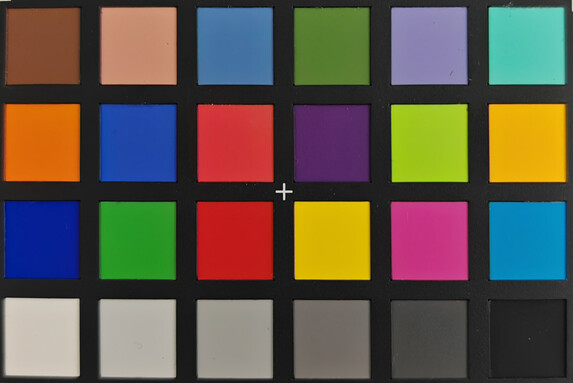

Accessories and Warranty - Plenty of accessories
Honor offers a warranty of 24 months on the Magic5 Pro 24, which cannot be expanded or extended. However, Honor also offers an additional display protection in the first six months, with a maximum service charge of 65 Euros (~$71) if the display has to be replaced.
There are no compromises in the number of accessories, and the box of the smartphone includes a modular 66-Watt charger, a USB cable (Type-A to Type-C), a SIM tool, and a transparent TPU protective case.
Input Devices and Operation - The Magic5 Pro becomes even more secure
The capacitive touchscreen of the Honor Magic5 Pro recognizes up to 10 touch points simultaneously and offers very good sliding characteristics, particularly also with the protective foil above the screen. Inputs are recognized reliably and implemented accurately. There is also an optical fingerprint sensor in the display. Not only does it unlock the smartphone quickly, but it also shows very good recognition rates. Unfortunately, Honor doesn't use an ultrasound version of the fingerprint sensor anymore, as in the Magic4 Pro before.
Unlocking via 3D face recognition (ToF) succeeds even faster, while being no less safe. In order to improve the security further, the Magic5 Pro uses a so-called Discrete Security Chipset, which provides additional protection for passwords and biometric data, in order to ensure maximum privacy.
In addition to Google Assistant, the Yoyo Assistant is also included, handling app suggestions and enabling functions such as Magic Text. The knuckle gestures that we already know from previous models are available again, and otherwise Honor also offers a few additional features such as Multi Window or Smart Sensing, which can be activated in the settings. A mode for single-handed operation is also included.
Display - Bright OLED with LTPO and 2.160-Hz DC dimming
The Honor Magi5 Pro has a 6.81-inch display that ensures a high pixel density with an extended Full-HD resolution. The system can adjust the refresh rate dynamically between 1 and 120 Hz, but you can also set this manually to 60, 90, or 120 Hz in the settings. Aside from Dolby Vision, all the usual HDR standards are supported.
The display brightness is very high with a pure white display and activated brightness sensor, reaching a very bright 1,289 cd/m² on average. With an even distribution of light and dark areas (APL18), this value doesn't increase much higher, reaching only 1,439 cd/m², which is significantly lower than the promised top brightness of 1,800 cd/m². If you adjust the brightness manually, up to 794 cd/m² are available.
In our measurement with the oscilloscope, we see only a constant flickering at 120 Hz. Behind this is some powerful DC dimming at 2,160 Hz, so that the eyes of the users should be protected as much as possible from the typical OLED flickering.
| |||||||||||||||||||||||||
Brightness Distribution: 96 %
Center on Battery: 1291 cd/m²
Contrast: ∞:1 (Black: 0 cd/m²)
ΔE ColorChecker Calman: 1.7 | ∀{0.5-29.43 Ø4.78}
ΔE Greyscale Calman: 2.9 | ∀{0.09-98 Ø5}
98.7% sRGB (Calman 2D)
Gamma: 2.28
CCT: 6472 K
| Honor Magic5 Pro OLED, 2848x1312, 6.8" | Samsung Galaxy S23 Ultra Dynamic AMOLED 2x, 3080x1440, 6.8" | Apple iPhone 14 Pro Max Super Retina XDR OLED, 2796x1290, 6.7" | Google Pixel 7 Pro OLED, 3120x1440, 6.7" | Xiaomi 13 Pro OLED, 3200x1440, 6.7" | Motorola Edge 30 Ultra pOLED, 2400x1080, 6.7" | Honor Magic4 Pro OLED, 2848x1312, 6.8" | |
|---|---|---|---|---|---|---|---|
| Screen | -4% | 11% | 21% | 18% | 11% | -21% | |
| Brightness middle (cd/m²) | 1291 | 1117 -13% | 1061 -18% | 1022 -21% | 1230 -5% | 1020 -21% | 956 -26% |
| Brightness (cd/m²) | 1289 | 1133 -12% | 1057 -18% | 1025 -20% | 1244 -3% | 1020 -21% | 959 -26% |
| Brightness Distribution (%) | 96 | 97 1% | 99 3% | 99 3% | 94 -2% | 96 0% | 94 -2% |
| Black Level * (cd/m²) | |||||||
| Colorchecker dE 2000 * | 1.7 | 2.2 -29% | 1.3 24% | 0.9 47% | 1 41% | 1 41% | 2.4 -41% |
| Colorchecker dE 2000 max. * | 4.4 | 3.9 11% | 3.1 30% | 2.1 52% | 2.8 36% | 2.8 36% | 5.2 -18% |
| Greyscale dE 2000 * | 2.9 | 2.3 21% | 1.6 45% | 1.1 62% | 1.8 38% | 2.1 28% | 3.3 -14% |
| Gamma | 2.28 96% | 2.37 93% | 2.19 100% | 2.22 99% | 2.24 98% | 2.29 96% | 2.26 97% |
| CCT | 6472 100% | 6572 99% | 6511 100% | 6650 98% | 6446 101% | 6502 100% | 6804 96% |
* ... smaller is better
Screen Flickering / PWM (Pulse-Width Modulation)
| Screen flickering / PWM detected | 120 Hz | ||
The display backlight flickers at 120 Hz (worst case, e.g., utilizing PWM) . The frequency of 120 Hz is very low, so the flickering may cause eyestrain and headaches after extended use. In comparison: 53 % of all tested devices do not use PWM to dim the display. If PWM was detected, an average of 8098 (minimum: 5 - maximum: 343500) Hz was measured. | |||
Measurements with fixed zoom level and various brightness settings
The color reproduction of the display can be very natural if you choose the right settings. For this, you need to select the Normal color mode and Standard color temperature in the display options. While you then won't be able to detect any color deviations with your bare eyes anymore, the white balance will also show a minimal green tint, although that won't be noticeable in daily operation. In the standard settings, the reproduction is cooler and the colors are more saturated, but the Magic5 Pro will then also cover the larger DCI P3 color space.
Display Response Times
| ↔ Response Time Black to White | ||
|---|---|---|
| 1.18 ms ... rise ↗ and fall ↘ combined | ↗ 0.6225 ms rise | |
| ↘ 0.5575 ms fall | ||
| The screen shows very fast response rates in our tests and should be very well suited for fast-paced gaming. In comparison, all tested devices range from 0.1 (minimum) to 240 (maximum) ms. » 5 % of all devices are better. This means that the measured response time is better than the average of all tested devices (20.2 ms). | ||
| ↔ Response Time 50% Grey to 80% Grey | ||
| 0.87 ms ... rise ↗ and fall ↘ combined | ↗ 0.3795 ms rise | |
| ↘ 0.491 ms fall | ||
| The screen shows very fast response rates in our tests and should be very well suited for fast-paced gaming. In comparison, all tested devices range from 0.165 (minimum) to 636 (maximum) ms. » 3 % of all devices are better. This means that the measured response time is better than the average of all tested devices (31.6 ms). | ||
Performance - The Magic5 Pro uses the Snapdragon 8 Gen 2
The Honor Magic5 Pro is run by the Snapdragon 8 Gen 2 with 12 GB of LPDDR5x working memory. This promises a very high performance, which is also confirmed by our benchmark results to a large extent. However other smartphones with the same SoC are often slightly faster, which already leads us to suspect that Honor is unable to optimally dissipate the heat of the chip.
In the system benchmarks, the smartphone performs at the expected level, placing with the top group in PCMark and AnTuTu and only remaining behind the expectations in CrossMark. However, we cannot complain in everyday operation, since the system runs butter smooth.
| UL Procyon AI Inference for Android - Overall Score NNAPI | |
| Honor Magic4 Pro | |
| Google Pixel 7 Pro | |
| Average of class Smartphone (3769 - 81594, n=135, last 2 years) | |
| Samsung Galaxy S23 Ultra | |
| Xiaomi 13 Pro | |
| Average Qualcomm Snapdragon 8 Gen 2 (11338 - 16880, n=21) | |
| Motorola Edge 30 Ultra | |
| Honor Magic5 Pro | |
The high-end Adreno 740 GPU handles the graphics acceleration. In the benchmarks, this results in a similar picture as in the CPU performance, with only the differences being smaller here. Only in the onscreen tests, the frame rates are often capped at 60 frames per second.
GFXBench (DX / GLBenchmark) 2.7: T-Rex Onscreen | 1920x1080 T-Rex Offscreen
GFXBench 3.0: on screen Manhattan Onscreen OGL | 1920x1080 1080p Manhattan Offscreen
GFXBench 3.1: on screen Manhattan ES 3.1 Onscreen | 1920x1080 Manhattan ES 3.1 Offscreen
GFXBench: on screen Car Chase Onscreen | 1920x1080 Car Chase Offscreen | on screen Aztec Ruins High Tier Onscreen | 2560x1440 Aztec Ruins High Tier Offscreen | on screen Aztec Ruins Normal Tier Onscreen | 1920x1080 Aztec Ruins Normal Tier Offscreen | 3840x2160 4K Aztec Ruins High Tier Offscreen
| 3DMark / Wild Life Extreme Unlimited | |
| Samsung Galaxy S23 Ultra | |
| Xiaomi 13 Pro | |
| Honor Magic5 Pro | |
| Apple iPhone 14 Pro Max | |
| Motorola Edge 30 Ultra | |
| Honor Magic4 Pro | |
| Google Pixel 7 Pro | |
| 3DMark / Wild Life Extreme | |
| Xiaomi 13 Pro | |
| Samsung Galaxy S23 Ultra | |
| Honor Magic5 Pro | |
| Apple iPhone 14 Pro Max | |
| Motorola Edge 30 Ultra | |
| Honor Magic4 Pro | |
| Google Pixel 7 Pro | |
| 3DMark / Wild Life Unlimited Score | |
| Samsung Galaxy S23 Ultra | |
| Xiaomi 13 Pro | |
| Honor Magic5 Pro | |
| Apple iPhone 14 Pro Max | |
| Motorola Edge 30 Ultra | |
| Honor Magic4 Pro | |
| Google Pixel 7 Pro | |
| 3DMark / Sling Shot Extreme (ES 3.1) Unlimited Physics | |
| Samsung Galaxy S23 Ultra | |
| Honor Magic5 Pro | |
| Motorola Edge 30 Ultra | |
| Google Pixel 7 Pro | |
| Honor Magic4 Pro | |
| 3DMark / Sling Shot Extreme (ES 3.1) Unlimited Graphics | |
| Honor Magic5 Pro | |
| Samsung Galaxy S23 Ultra | |
| Motorola Edge 30 Ultra | |
| Honor Magic4 Pro | |
| Google Pixel 7 Pro | |
| 3DMark / Sling Shot Extreme (ES 3.1) Unlimited | |
| Honor Magic5 Pro | |
| Samsung Galaxy S23 Ultra | |
| Motorola Edge 30 Ultra | |
| Honor Magic4 Pro | |
| Google Pixel 7 Pro | |
| GFXBench (DX / GLBenchmark) 2.7 / T-Rex Onscreen | |
| Motorola Edge 30 Ultra | |
| Google Pixel 7 Pro | |
| Xiaomi 13 Pro | |
| Samsung Galaxy S23 Ultra | |
| Honor Magic4 Pro | |
| Apple iPhone 14 Pro Max | |
| Honor Magic5 Pro | |
| GFXBench (DX / GLBenchmark) 2.7 / T-Rex Offscreen | |
| Xiaomi 13 Pro | |
| Samsung Galaxy S23 Ultra | |
| Honor Magic5 Pro | |
| Motorola Edge 30 Ultra | |
| Apple iPhone 14 Pro Max | |
| Honor Magic4 Pro | |
| Google Pixel 7 Pro | |
| GFXBench 3.0 / Manhattan Onscreen OGL | |
| Motorola Edge 30 Ultra | |
| Xiaomi 13 Pro | |
| Samsung Galaxy S23 Ultra | |
| Honor Magic4 Pro | |
| Google Pixel 7 Pro | |
| Apple iPhone 14 Pro Max | |
| Honor Magic5 Pro | |
| GFXBench 3.0 / 1080p Manhattan Offscreen | |
| Xiaomi 13 Pro | |
| Apple iPhone 14 Pro Max | |
| Samsung Galaxy S23 Ultra | |
| Honor Magic5 Pro | |
| Motorola Edge 30 Ultra | |
| Honor Magic4 Pro | |
| Google Pixel 7 Pro | |
| GFXBench 3.1 / Manhattan ES 3.1 Onscreen | |
| Motorola Edge 30 Ultra | |
| Xiaomi 13 Pro | |
| Honor Magic4 Pro | |
| Samsung Galaxy S23 Ultra | |
| Apple iPhone 14 Pro Max | |
| Honor Magic5 Pro | |
| Google Pixel 7 Pro | |
| GFXBench 3.1 / Manhattan ES 3.1 Offscreen | |
| Xiaomi 13 Pro | |
| Honor Magic5 Pro | |
| Samsung Galaxy S23 Ultra | |
| Apple iPhone 14 Pro Max | |
| Motorola Edge 30 Ultra | |
| Honor Magic4 Pro | |
| Google Pixel 7 Pro | |
| GFXBench / Car Chase Onscreen | |
| Motorola Edge 30 Ultra | |
| Samsung Galaxy S23 Ultra | |
| Xiaomi 13 Pro | |
| Apple iPhone 14 Pro Max | |
| Honor Magic5 Pro | |
| Honor Magic4 Pro | |
| Google Pixel 7 Pro | |
| GFXBench / Car Chase Offscreen | |
| Xiaomi 13 Pro | |
| Honor Magic5 Pro | |
| Samsung Galaxy S23 Ultra | |
| Motorola Edge 30 Ultra | |
| Apple iPhone 14 Pro Max | |
| Honor Magic4 Pro | |
| Google Pixel 7 Pro | |
| GFXBench / Aztec Ruins High Tier Onscreen | |
| Motorola Edge 30 Ultra | |
| Samsung Galaxy S23 Ultra | |
| Honor Magic5 Pro | |
| Apple iPhone 14 Pro Max | |
| Xiaomi 13 Pro | |
| Honor Magic4 Pro | |
| Google Pixel 7 Pro | |
| GFXBench / Aztec Ruins High Tier Offscreen | |
| Honor Magic5 Pro | |
| Samsung Galaxy S23 Ultra | |
| Xiaomi 13 Pro | |
| Motorola Edge 30 Ultra | |
| Honor Magic4 Pro | |
| Apple iPhone 14 Pro Max | |
| Google Pixel 7 Pro | |
| GFXBench / Aztec Ruins Normal Tier Onscreen | |
| Motorola Edge 30 Ultra | |
| Samsung Galaxy S23 Ultra | |
| Xiaomi 13 Pro | |
| Honor Magic4 Pro | |
| Apple iPhone 14 Pro Max | |
| Honor Magic5 Pro | |
| Google Pixel 7 Pro | |
| GFXBench / Aztec Ruins Normal Tier Offscreen | |
| Xiaomi 13 Pro | |
| Samsung Galaxy S23 Ultra | |
| Apple iPhone 14 Pro Max | |
| Honor Magic5 Pro | |
| Motorola Edge 30 Ultra | |
| Honor Magic4 Pro | |
| Google Pixel 7 Pro | |
| GFXBench / 4K Aztec Ruins High Tier Offscreen | |
| Samsung Galaxy S23 Ultra | |
| Honor Magic5 Pro | |
| Xiaomi 13 Pro | |
| Motorola Edge 30 Ultra | |
| Apple iPhone 14 Pro Max | |
| Honor Magic4 Pro | |
| Google Pixel 7 Pro | |
In the browser benchmarks with Chrome, the Magic5 Pro delivers mostly rather average results within its performance class. However, this is not noticeable in everyday operation, since websites load very fast.
| Jetstream 2 - 2.0 Total Score | |
| Apple iPhone 14 Pro Max (Safari 16) | |
| Samsung Galaxy S23 Ultra (Chrome 109) | |
| Average of class Smartphone (23.8 - 387, n=149, last 2 years) | |
| Xiaomi 13 Pro (Chrome 109) | |
| Average Qualcomm Snapdragon 8 Gen 2 (62.7 - 179.2, n=23) | |
| Motorola Edge 30 Ultra (Chrome 105) | |
| Honor Magic5 Pro (Chrome 111) | |
| Google Pixel 7 Pro (Chrome 106) | |
| Honor Magic4 Pro (Chrome 102) | |
| Speedometer 2.0 - Result 2.0 | |
| Apple iPhone 14 Pro Max (Safari 16) | |
| Average of class Smartphone (15.2 - 643, n=122, last 2 years) | |
| Samsung Galaxy S23 Ultra (Chrome 109) | |
| Average Qualcomm Snapdragon 8 Gen 2 (62.9 - 225, n=18) | |
| Honor Magic5 Pro (Chrome 111) | |
| Xiaomi 13 Pro (Chrome 109) | |
| Google Pixel 7 Pro (Chrome 106) | |
| Motorola Edge 30 Ultra (Chrome 105) | |
| Honor Magic4 Pro (Chrome 102) | |
| WebXPRT 4 - Overall | |
| Apple iPhone 14 Pro Max (Safari 16) | |
| Xiaomi 13 Pro (Chrome 109) | |
| Average of class Smartphone (27 - 306, n=145, last 2 years) | |
| Samsung Galaxy S23 Ultra (Chrome 110) | |
| Average Qualcomm Snapdragon 8 Gen 2 (28 - 183, n=22) | |
| Motorola Edge 30 Ultra (Chrome 105) | |
| Honor Magic5 Pro (Chrome 111) | |
| Google Pixel 7 Pro (Chrome 106) | |
| Honor Magic4 Pro (Chrome 102) | |
| Octane V2 - Total Score | |
| Apple iPhone 14 Pro Max (Safari 16) | |
| Samsung Galaxy S23 Ultra (Chrome 109) | |
| Average of class Smartphone (2228 - 121337, n=197, last 2 years) | |
| Average Qualcomm Snapdragon 8 Gen 2 (19870 - 65418, n=25) | |
| Google Pixel 7 Pro (Chrome 106) | |
| Xiaomi 13 Pro (Chrome 109) | |
| Honor Magic5 Pro (Chrome 111) | |
| Motorola Edge 30 Ultra (Chrome 105) | |
| Honor Magic4 Pro (Chrome 102) | |
| Mozilla Kraken 1.1 - Total | |
| Honor Magic4 Pro (Chrome 102) | |
| Average of class Smartphone (257 - 28190, n=155, last 2 years) | |
| Motorola Edge 30 Ultra (Chrome 105) | |
| Average Qualcomm Snapdragon 8 Gen 2 (602 - 1837, n=22) | |
| Google Pixel 7 Pro (Chrome 106) | |
| Honor Magic5 Pro (Chrome 111) | |
| Xiaomi 13 Pro (Chrome 109) | |
| Samsung Galaxy S23 Ultra (Chrome 109) | |
| Apple iPhone 14 Pro Max (Safari 16) | |
* ... smaller is better
The Honor Magic4 Pro possesses 512 GB of UFS 4.0 storage. The storage speed turns out correspondingly fast, at least in sequential reading and writing of data. With smaller data blocks, the smartphone performs below its potential.
| Honor Magic5 Pro | Samsung Galaxy S23 Ultra | Google Pixel 7 Pro | Xiaomi 13 Pro | Motorola Edge 30 Ultra | Honor Magic4 Pro | Average 512 GB UFS 4.0 Flash | Average of class Smartphone | |
|---|---|---|---|---|---|---|---|---|
| AndroBench 3-5 | -7% | -40% | 33% | -5% | -17% | 33% | -10% | |
| Sequential Read 256KB (MB/s) | 3344.12 | 3426.56 2% | 1346.78 -60% | 3587.83 7% | 1717.77 -49% | 1868.5 -44% | 3689 ? 10% | 2228 ? -33% |
| Sequential Write 256KB (MB/s) | 2651.87 | 1389.84 -48% | 874.73 -67% | 2601.45 -2% | 1363.58 -49% | 1367.48 -48% | 3092 ? 17% | 1852 ? -30% |
| Random Read 4KB (MB/s) | 267.91 | 449.77 68% | 219.01 -18% | 387.72 45% | 349.08 30% | 268.76 0% | 385 ? 44% | 296 ? 10% |
| Random Write 4KB (MB/s) | 298.31 | 152.92 -49% | 253.18 -15% | 546.98 83% | 446.25 50% | 366.13 23% | 474 ? 59% | 339 ? 14% |
Games - PUBG Mobile at up to 90 FPS
The Adreno 740 offers more than sufficient performance for all the games from the Play Store and in addition supports all the current graphics connections. However, we can still see a few limitations in the Honor Magic5 Pro.
But this isn't the case in PUBG Mobile. The shooter game runs absolutely free from any stutters in all the graphics settings. In Ultra-HD mode, this means a stable 40 FPS, and if you reduce the settings to a minimum, you even get 90 FPS. World of Tanks likewise doesn't show any stutters at any time and can be run in all its glory, but the 120-FPS option is unfortunately not available. We tested both games using GameBench.
In addition, the Honor offers a so-called Game Manager in its system, which includes a few comfort functions. However, screen recordings are only created at the slightly peculiar resolution of 1,280 x 588 pixels.
Emissions - Honor smartphone with weak SoC cooling
Temperatures
During idle operation, the Honor Magic5 Pro remains comfortably cool at all times. Under load, it gets noticeably warmer, without ever getting too hot at a maximum of 34 °C (93 °F).
We already saw some indications in the benchmarks, and the stress test of 3DMark Wild Life (Extreme) then confirms that the performance doesn't remain stable over long time periods. In all three scenarios, the performance of the Honor smartphone drops by at least 50% of its original value. Until now, this has not been the case for any other smartphone with the Snapdragon 8 Gen 2 that we tested. While this is not noticeable in system operation or while gaming, it also explains the FPS limit in World of Tanks.
(+) The maximum temperature on the upper side is 34 °C / 93 F, compared to the average of 35.2 °C / 95 F, ranging from 21.9 to 247 °C for the class Smartphone.
(+) The bottom heats up to a maximum of 31.6 °C / 89 F, compared to the average of 34 °C / 93 F
(+) In idle usage, the average temperature for the upper side is 31.7 °C / 89 F, compared to the device average of 32.9 °C / 91 F.
3DMark Wild Life Stress Test
| 3DMark | |
| Wild Life Stress Test Stability | |
| Xiaomi 13 Pro | |
| Apple iPhone 14 Pro Max | |
| Samsung Galaxy S23 Ultra | |
| Google Pixel 7 Pro | |
| Honor Magic4 Pro | |
| Motorola Edge 30 Ultra | |
| Honor Magic5 Pro | |
| Wild Life Extreme Stress Test | |
| Xiaomi 13 Pro | |
| Google Pixel 7 Pro | |
| Apple iPhone 14 Pro Max | |
| Motorola Edge 30 Ultra | |
| Honor Magic4 Pro | |
| Samsung Galaxy S23 Ultra | |
| Honor Magic5 Pro | |
Speakers
The Honor Magic5 Pro offers an attractive pair of speakers that ensure a good sound output including DTS:X. While the mids could be slightly more present, this isn't very noticeable at medium volume levels.
Those who want to connect headphones or speakers to the smartphone can use the USB port for wired connections or Bluetooth 5.2 for a wireless connection. Unfortunately, there is no readout of the audio-codec support, but using headphones with SBC, AAC, aptX, aptX HD, and LDAC worked without any problems.
Honor Magic5 Pro audio analysis
(+) | speakers can play relatively loud (86 dB)
Bass 100 - 315 Hz
(-) | nearly no bass - on average 23.6% lower than median
(±) | linearity of bass is average (10.1% delta to prev. frequency)
Mids 400 - 2000 Hz
(±) | reduced mids - on average 6.3% lower than median
(±) | linearity of mids is average (7.8% delta to prev. frequency)
Highs 2 - 16 kHz
(+) | balanced highs - only 3.1% away from median
(+) | highs are linear (2.9% delta to prev. frequency)
Overall 100 - 16.000 Hz
(±) | linearity of overall sound is average (16.5% difference to median)
Compared to same class
» 7% of all tested devices in this class were better, 5% similar, 88% worse
» The best had a delta of 11%, average was 35%, worst was 134%
Compared to all devices tested
» 27% of all tested devices were better, 6% similar, 67% worse
» The best had a delta of 4%, average was 24%, worst was 134%
Samsung Galaxy S23 Ultra audio analysis
(+) | speakers can play relatively loud (91.8 dB)
Bass 100 - 315 Hz
(-) | nearly no bass - on average 19.4% lower than median
(+) | bass is linear (5.1% delta to prev. frequency)
Mids 400 - 2000 Hz
(±) | reduced mids - on average 5.1% lower than median
(+) | mids are linear (4.2% delta to prev. frequency)
Highs 2 - 16 kHz
(±) | higher highs - on average 6.2% higher than median
(+) | highs are linear (2.5% delta to prev. frequency)
Overall 100 - 16.000 Hz
(±) | linearity of overall sound is average (15.6% difference to median)
Compared to same class
» 4% of all tested devices in this class were better, 3% similar, 93% worse
» The best had a delta of 11%, average was 35%, worst was 134%
Compared to all devices tested
» 23% of all tested devices were better, 4% similar, 73% worse
» The best had a delta of 4%, average was 24%, worst was 134%
Battery Life - 5,100 mAh for long runtimes
Power Consumption
The power consumption of the Honor Magic5 Pro is at a low level, and it was improved particularly at maximum brightness.
In our tests at an adjusted display brightness (150 cd/m²), the Honor smartphone presents itself as efficient, with the consumption only being fairly high during idle operation. Using the included 66-Watt charger, the battery can be completely recharged within 47 minutes, reaching the 50% mark already after 16, and 80% after 32 minutes. While this is still very fast, Honor has reduced the charging performance compared to the predecessor (100 watts) here. On the other hand, you can still use wireless charging at up to 50 watts, and reverse charging is also supported.
| Off / Standby | |
| Idle | |
| Load |
|
Key:
min: | |
| Honor Magic5 Pro 5100 mAh | Samsung Galaxy S23 Ultra 5000 mAh | Apple iPhone 14 Pro Max 4323 mAh | Google Pixel 7 Pro 5000 mAh | Xiaomi 13 Pro 4820 mAh | Motorola Edge 30 Ultra 4610 mAh | Honor Magic4 Pro 4600 mAh | Average Qualcomm Snapdragon 8 Gen 2 | Average of class Smartphone | |
|---|---|---|---|---|---|---|---|---|---|
| Power Consumption | -11% | -11% | -8% | -18% | -2% | -42% | -69% | -59% | |
| Idle Minimum * (Watt) | 0.91 | 0.9 1% | 0.61 33% | 0.78 14% | 1.02 -12% | 0.74 19% | 0.87 4% | 1.036 ? -14% | 0.842 ? 7% |
| Idle Average * (Watt) | 1.63 | 1.05 36% | 1.7 -4% | 1.61 1% | 1.36 17% | 1.84 -13% | 2.04 -25% | 1.766 ? -8% | 1.439 ? 12% |
| Idle Maximum * (Watt) | 1.67 | 1.1 34% | 1.73 -4% | 1.63 2% | 1.58 5% | 1.86 -11% | 2.26 -35% | 1.94 ? -16% | 1.624 ? 3% |
| Load Average * (Watt) | 2.61 | 3.99 -53% | 3.85 -48% | 3.29 -26% | 4.29 -64% | 2.75 -5% | 4.97 -90% | 7.22 ? -177% | 7.03 ? -169% |
| Load Maximum * (Watt) | 4.57 | 7.82 -71% | 5.94 -30% | 6.01 -32% | 6.15 -35% | 4.54 1% | 7.46 -63% | 10.4 ? -128% | 11.3 ? -147% |
* ... smaller is better
Power Consumption: Geekbench (150 cd/m²)
Power Consumption: GFXBench (150 cd/m²)
Battery Life
With its powerful 5,100 mAh battery, the Honor Magic5 Pro offers a long battery life, surpassing most of its competitors. But particularly during video reproduction, the Galaxy S23 Ultra and iPhone 14 Pro Max still last significantly longer.
| Honor Magic5 Pro 5100 mAh | Samsung Galaxy S23 Ultra 5000 mAh | Apple iPhone 14 Pro Max 4323 mAh | Google Pixel 7 Pro 5000 mAh | Xiaomi 13 Pro 4820 mAh | Motorola Edge 30 Ultra 4610 mAh | Honor Magic4 Pro 4600 mAh | |
|---|---|---|---|---|---|---|---|
| Battery runtime | 14% | 27% | -28% | -18% | -5% | -16% | |
| Reader / Idle (h) | 43 | 35.7 -17% | 57.9 35% | 20.2 -53% | 25.2 -41% | 36.8 -14% | 22.4 -48% |
| H.264 (h) | 20.8 | 25.7 24% | 28.1 35% | 20.2 -3% | 21.1 1% | 19.8 -5% | 16.6 -20% |
| WiFi v1.3 (h) | 17.9 | 18.3 2% | 15.8 -12% | 11.3 -37% | 14.1 -21% | 14.5 -19% | 11.5 -36% |
| Load (h) | 4.6 | 6.7 46% | 6.9 50% | 3.8 -17% | 4.2 -9% | 5.4 17% | 6.5 41% |
Pros
Cons
Verdict - A powerful high-end smartphone with few weaknesses
With the Magic5 Pro, Honor continues to improve its predecessor, offering an overall package that includes powerful technology and doesn't have to hide from any competitors. Particularly in terms of security, Honor takes an additional step, introducing a dedicated security chipset for the first time, and it is currently also the only Android smartphone with 3D face recognition.
The Honor Magic5 Pro is a first-rate Android smartphone that shows only minor weaknesses.
In our test, the smartphone impresses with its bright and accurate LTPO display, even though the top brightness remains clearly behind the promised 1,800 cd/m². An additional highlight is the 50-MP triple-camera system that offers a convincing performance in terms of photography as well as recording videos, although it still needs some refinement. In addition, Honor has again increased the period of guaranteed updates, now offering the same time period as Google does for its Pixel smartphones.
The Magic5 Pro deserves some critique particularly for its weak SoC cooling. Under longer load, the performance drop turns out higher than on average. It is also a little strange that Wi-Fi 7 is nominally supported, but the Honor smartphone is unable to use a 6-GHz net.
Other powerful alternatives to the Magic5 Pro are the Xiaomi 13 Pro and the Samsung Galaxy S23 Ultra, even though they also emphasize some different areas.
Price and Availability
The Honor Magic5 Pro is supposed to be available in Europe including the UK but not the US where you will only be able to purchase it from international vendors. Amazon, for example, only shows some case covers and screen protectors for it. The Honor shop lists the Honor Magic5 Pro for £949.99 in the UK and for 1,199.90 Euros in Germany.
Honor Magic5 Pro
- 04/17/2023 v7 (old)
Daniel Schmidt
Transparency
The selection of devices to be reviewed is made by our editorial team. The test sample was given to the author by the manufacturer free of charge for the purposes of review. There was no third-party influence on this review, nor did the manufacturer receive a copy of this review before publication. There was no obligation to publish this review. As an independent media company, Notebookcheck is not subjected to the authority of manufacturers, retailers or publishers.
This is how Notebookcheck is testing
Every year, Notebookcheck independently reviews hundreds of laptops and smartphones using standardized procedures to ensure that all results are comparable. We have continuously developed our test methods for around 20 years and set industry standards in the process. In our test labs, high-quality measuring equipment is utilized by experienced technicians and editors. These tests involve a multi-stage validation process. Our complex rating system is based on hundreds of well-founded measurements and benchmarks, which maintains objectivity. Further information on our test methods can be found here.




